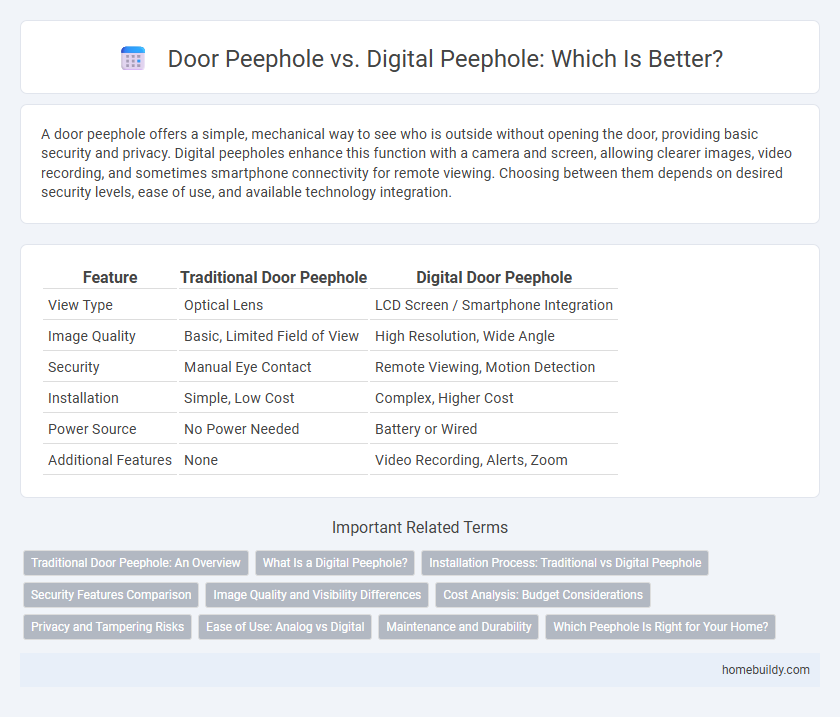A door peephole offers a simple, mechanical way to see who is outside without opening the door, providing basic security and privacy. Digital peepholes enhance this function with a camera and screen, allowing clearer images, video recording, and sometimes smartphone connectivity for remote viewing. Choosing between them depends on desired security levels, ease of use, and available technology integration.
Table of Comparison
| Feature | Traditional Door Peephole | Digital Door Peephole |
|---|---|---|
| View Type | Optical Lens | LCD Screen / Smartphone Integration |
| Image Quality | Basic, Limited Field of View | High Resolution, Wide Angle |
| Security | Manual Eye Contact | Remote Viewing, Motion Detection |
| Installation | Simple, Low Cost | Complex, Higher Cost |
| Power Source | No Power Needed | Battery or Wired |
| Additional Features | None | Video Recording, Alerts, Zoom |
Traditional Door Peephole: An Overview
Traditional door peepholes consist of a simple lens embedded in the door, allowing users to see outside without opening it. They provide a wide-angle view and operate without batteries or electronics, ensuring reliability and low maintenance. Despite lacking digital features, traditional peepholes offer effective privacy and security at a lower cost compared to digital alternatives.
What Is a Digital Peephole?
A digital peephole is an advanced security device that replaces traditional optical peepholes with a digital camera and LCD screen, providing a clearer and wider field of view. Unlike standard peepholes that can be limited by lighting and angle, digital peepholes offer features such as video recording, night vision, and remote viewing via smartphone apps. This technology enhances home security by allowing users to monitor visitors more effectively and maintain a visual log of door activity.
Installation Process: Traditional vs Digital Peephole
Traditional door peepholes require simple installation involving drilling a small hole through the door and securing the lens with a threaded housing, usually taking just a few minutes. Digital peepholes involve more complex installation, including mounting a camera on the exterior, placing a digital display inside, and connecting batteries or power sources, which can take significantly longer and may require technical skills. The digital installation process often includes calibration and setup of features like motion detection or video recording, making it more involved than the straightforward hardware fitting of traditional peepholes.
Security Features Comparison
Traditional door peepholes offer a simple, wide-angle view of visitors but lack advanced security features such as recording or remote monitoring. Digital peepholes enhance security by incorporating high-definition cameras, night vision, and smartphone integration, enabling users to see and record visitors in real-time from any location. The ability to store footage and receive alerts significantly improves threat detection and home security compared to conventional peepholes.
Image Quality and Visibility Differences
Traditional door peepholes offer limited image quality with a narrow, fisheye view that can distort visibility and restrict the field of sight. Digital peepholes use high-resolution cameras and LCD screens to provide clear, wide-angle views with enhanced brightness and night vision, significantly improving safety and convenience. This advanced technology also allows for image capture and remote viewing, features unavailable in standard peepholes.
Cost Analysis: Budget Considerations
Traditional door peepholes offer a low-cost security solution, typically priced between $5 and $20, making them accessible for budget-conscious homeowners. Digital peepholes, while initially more expensive with prices ranging from $50 to $150, provide enhanced features such as video recording and remote viewing, which can justify the higher investment for improved security. Maintenance costs for traditional peepholes remain minimal, whereas digital options may incur additional expenses for battery replacements and occasional software updates.
Privacy and Tampering Risks
Traditional door peepholes offer privacy by limiting the viewing angle to the homeowner, minimizing external visibility; however, they are susceptible to tampering or reverse visualization using specialized lenses. Digital peepholes enhance privacy with encrypted video transmission and can include tampering alerts, yet they rely on electronic components that may be vulnerable to hacking or power failures. Evaluating privacy concerns involves balancing the mechanical simplicity of traditional peepholes against the advanced security features and potential cyber risks inherent in digital systems.
Ease of Use: Analog vs Digital
Traditional door peepholes offer ease of use through their simple design, requiring only a direct look through the lens for a clear view of visitors. Digital peepholes enhance convenience by providing a larger screen display and remote viewing options, eliminating the need to physically approach the door. While analog peepholes excel in immediate, straightforward use without power dependence, digital models offer user-friendly features such as zoom, recording, and night vision for improved security and accessibility.
Maintenance and Durability
Traditional door peepholes require minimal maintenance, typically limited to occasional cleaning of the lens to maintain clear visibility, and they are highly durable due to their simple mechanical design and lack of electronic components. In contrast, digital peepholes involve electronic parts such as cameras, displays, and batteries, necessitating regular charging or battery replacement and occasional software updates to ensure optimal functionality. While digital peepholes offer advanced features, their durability can be compromised by environmental factors like moisture and temperature fluctuations, making maintenance more critical compared to the robust, low-maintenance nature of traditional door peepholes.
Which Peephole Is Right for Your Home?
Traditional door peepholes offer a simple, cost-effective way to see visitors with a wide-angle lens, ensuring basic security without power needs. Digital peepholes provide enhanced features like a high-resolution LCD screen, night vision, and video recording, ideal for tech-savvy homeowners seeking advanced monitoring. Choosing the right peephole depends on your budget, desired security level, and preference for smart home integration.
door peephole vs digital peephole Infographic

 homebuildy.com
homebuildy.com